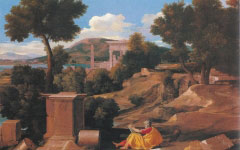Poussin’s Ordination (1640’s)
The highlight of Christie’s upcoming Old Masters sale in London (Dec. 7th 2010) is Poussin’s Ordination. It is a good example of how, if you are aware of certain common themes in art and common methods of composition, you can often see what experts never have. Not even when the price tag, as here, is over $30 million. [It failed to sell at that price, later sold privately to the Kimbell Art Museum, Fort Worth, Texas] Let's take a look.
The scene seems simple enough, Christ handing over the keys of the Church to St. Peter watched by his apostles. Strange features, though, long noted by experts, warn that Poussin is not illustrating a conventional story.1 Yet the strangest feature is the landscape which Christie's notes is distinctly different from the other landscape in the series.2 That should have alerted them that the highest rock, outlined against the sky, resembles the tip of a nose. In fact, the landscape is the most important feature of the painting, without which the image cannot be understood. Turn the painting on its side and you will see what I mean.
Click next thumbnail to continue.
Look first at the image on the left. What you should see is the prototypical profile of Christ's head facing left behind the main trees. The tip of his nose is the outcrop of rock and his parted lips the foliage below. The contour of his nose runs up unseen behind the trees towards his forehead which is even less distinctly identified. The eye is clearly positioned by a small eyeball-like mound behind two trees which cross their trunks. Use the diagram to help guide you and click on the image itself to enlarge it.
Click next thumbnail to continue

Top: Detail of "Christ's hidden eye" from Ordination with diagram
Bottom: Poussin's Ordination with indication of detail above
Click image to enlarge.
The discovery changes the image from an illustration of a Bible story to a visual poem on spirituality and the creative moment. The foreground scene of Christ handing over the keys to St. Peter now takes place inside the mind of this "larger Christ" looking upwards. To indicate that this Christ is an aspect of Poussin himself, the artist shaped the tree trunks over Christ's "eye", the eye of the artist, into the shape of his own initial N, for Nicolas.
See conclusion below
Poussin, like almost all great artists, believed that God or divinity was inside himself. Indeed Anthony Blunt has already written of The Ordination and other pictures in the same series that Poussin was attempting to depict the basic beliefs that run through all religions, Christian or pagan.3 He is certainly right because one of those beliefs, a key principle of the Inner Tradition, is that divinity is inside us, not out. I have not had time to consider this picture at length but my first impression is that Christ in handing over the keys to St. Peter is, in Poussin's mind, passing on "divine authority" to Poussin himself. Poussin as St. Peter now becomes God's representative in painting. And just as St. Peter is Poussin's alter ego so are all the apostles, Judas included who is dressed in green, the color of fertility. Chaos and suffering, which Judas causes, are crucial to creativity. Each one of the apostles, though, represents a different aspect of Poussin's mind, whether good or bad. That explains why so many of the faces resemble one other. They are all "Poussin".
Artists will recognize this method and its meaning as the way artists themselves think. Balthus did. He was probably inspired by Poussin's Ordination when he miraculously turned Poussin's own head into the shape of a mountain. See the entry on Balthus' The Mountain. It, too, has never been recognized for what it is.
More Works by Poussin
Notes:
1. Among the strange features are the group of toga-clad figures reclining among the trees and another figure unrelated to the story strolling out of the picture to the left reading a book. They have been identified by one expert as classical philosophers. In a novel move Poussin also clad all the figures in the costume of the early Church, a time when he may well have believed correctly that followers of esoteric Christianity were more numerous and well-established. (Christies' Old Master and Nineteenth-Century Paintings, Drawings and Watercolors, London, Dec. 7th 2010, pp. 174-5
2. ibid. p. 177
3. Cited in ibid. p. 173
Original Publication Date on EPPH: 28 Nov 2010. | Updated: 0. © Simon Abrahams. Articles on this site are the copyright of Simon Abrahams. To use copyrighted material in print or other media for purposes beyond 'fair use', you must obtain permission from the copyright owner. Websites may link to this page without permission (please do) but may not reproduce the material on their own site without crediting Simon Abrahams and EPPH.



